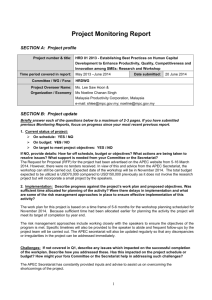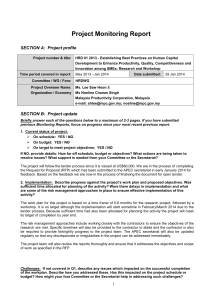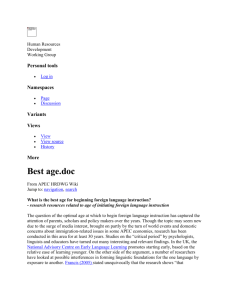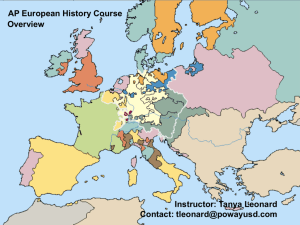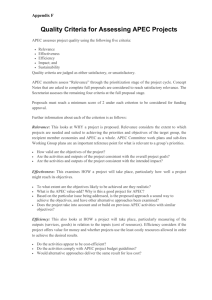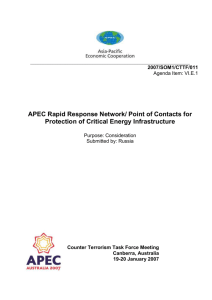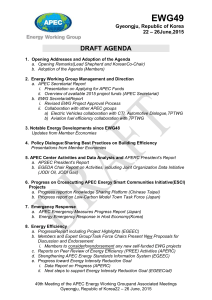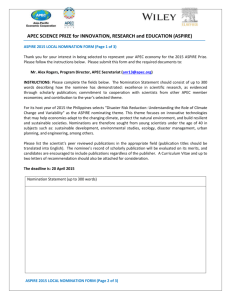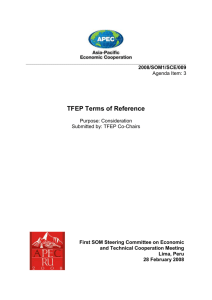Guide on Gender Criteria for APEC Project Proposals
advertisement
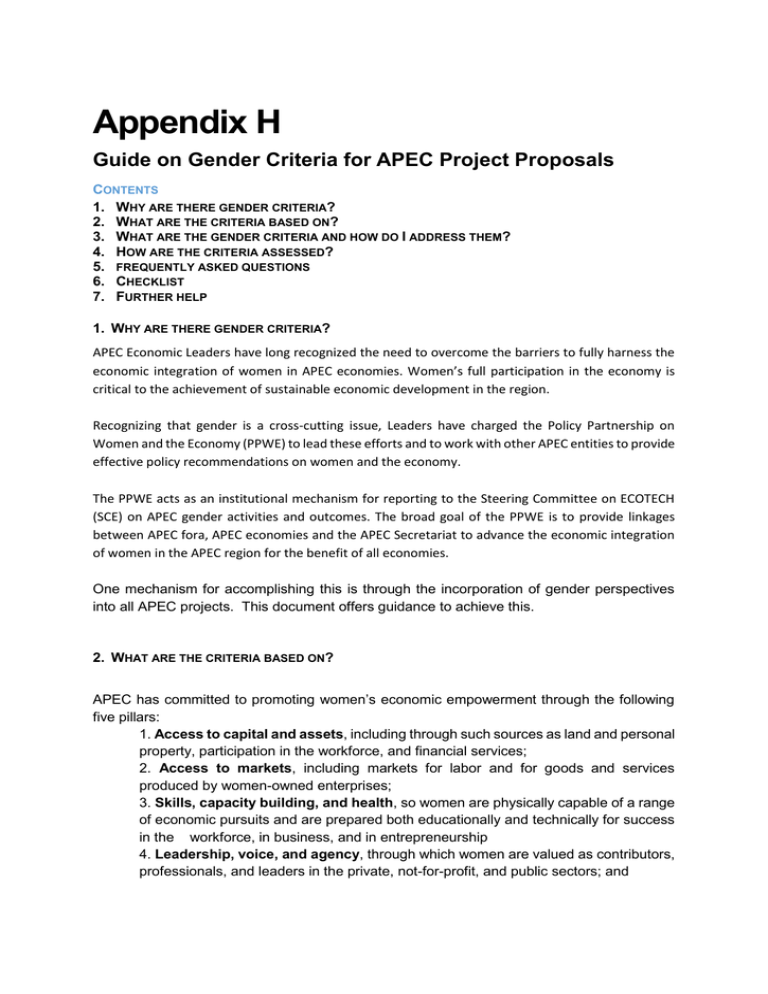
Appendix H Guide on Gender Criteria for APEC Project Proposals CONTENTS 1. WHY ARE THERE GENDER CRITERIA? 2. WHAT ARE THE CRITERIA BASED ON? 3. WHAT ARE THE GENDER CRITERIA AND HOW DO I ADDRESS THEM? 4. HOW ARE THE CRITERIA ASSESSED? 5. FREQUENTLY ASKED QUESTIONS 6. CHECKLIST 7. FURTHER HELP 1. WHY ARE THERE GENDER CRITERIA? APEC Economic Leaders have long recognized the need to overcome the barriers to fully harness the economic integration of women in APEC economies. Women’s full participation in the economy is critical to the achievement of sustainable economic development in the region. Recognizing that gender is a cross-cutting issue, Leaders have charged the Policy Partnership on Women and the Economy (PPWE) to lead these efforts and to work with other APEC entities to provide effective policy recommendations on women and the economy. The PPWE acts as an institutional mechanism for reporting to the Steering Committee on ECOTECH (SCE) on APEC gender activities and outcomes. The broad goal of the PPWE is to provide linkages between APEC fora, APEC economies and the APEC Secretariat to advance the economic integration of women in the APEC region for the benefit of all economies. One mechanism for accomplishing this is through the incorporation of gender perspectives into all APEC projects. This document offers guidance to achieve this. 2. WHAT ARE THE CRITERIA BASED ON? APEC has committed to promoting women’s economic empowerment through the following five pillars: 1. Access to capital and assets, including through such sources as land and personal property, participation in the workforce, and financial services; 2. Access to markets, including markets for labor and for goods and services produced by women-owned enterprises; 3. Skills, capacity building, and health, so women are physically capable of a range of economic pursuits and are prepared both educationally and technically for success in the workforce, in business, and in entrepreneurship 4. Leadership, voice, and agency, through which women are valued as contributors, professionals, and leaders in the private, not-for-profit, and public sectors; and 5. Innovation and technology, so women have the same opportunities as men to benefit from and participate in development and implementation of scientific advances and new technologies. 3. WHAT ARE THE GENDER CRITERIA AND HOW DO I ADDRESS THEM? APEC project proposals contain one question on gender considerations. To demonstrate your project will benefit women, and in particular will not disadvantage women, you need to describe what you are doing to include women and women’s perspectives in the design, implementation and evaluation of your project. How? Ways in which you can demonstrate you are doing this include, but are not limited to, the following: by analyzing if there are significant, relevant gender disparities in the sector in which your project is working and if so, ensuring that any which affect your project are addressed through project activities/inputs (Note: although it is less common, this could include gender disparities which affect men adversely); and/or, by describing how women will be included in the planning of the project, including in decision-making processes; and/or by describing how women will be consulted during the development of the project; and/or by describing what processes are in place to actively encourage women to participate in the implementation of the project; and/or by describing how the results of the project will be disseminated to women, women’s groups, peak bodies, or women’s government agencies; and/or by describing how the project will collect and use sex-disaggregated data to analyze the impact of the project on women. To demonstrate how the objectives of your project provide benefits for both women and men, you need to describe: how does your project aim to implement or facilitate or contribute to APEC objectives? and, in what way the project benefits or impacts (if any) women or men. How? Ways in which you can demonstrate that the objectives of your project will benefit both women and men include, but are not limited to the following: By specifically setting out how the objectives of the project will encourage both women and men’s participation in economic, technical, trade and business activities. For example: — The project will provide gender-sensitive training to women in economic or technical areas which have a small concentration of women, thereby empowering women to enter that field. — By describing how the project will streamline business regulation processes, thereby encouraging women-operated small and medium enterprises to move into the formal sector. By describing how the objectives of the project will contribute an understanding of gender considerations (or gender analysis) in APEC objectives. For example: — The conference/research/training will include a specific component on the issue as it relates to women. — Gender-sensitive indicators are utilized for monitoring the impact of the project. — The project’s reports and recommendations will focus on the longer-term outcomes for women and men. By describing how the project will encourage women’s participation in APEC. For example: — The project will collect and use sex-disaggregated data from participants (according to sex, age and urban/rural precedence). 4. HOW ARE THE CRITERIA ASSESSED? The APEC Secretariat designed a Gender Focal Point to coordinate within the PMU to assist the Women and the Economy Program Director in assessing the proposals submitted to APEC. It will provide advice to the Program Director on the extent to which the gender criteria are addressed in project proposals. The group will facilitate technical assistance if necessary. In assessing your response to the gender criteria, the Gender Focal Point and Program Director will be looking for evidence that the PO has genuinely investigated the gender considerations relevant to the project. To make a judgment about this they will consider the following: 1) 2) 3) 4) Does the proposal answer the question? Does the proposal provide evidence or examples? Where evidence and examples are not used, is a rationale provided? Does the proposal demonstrate an understanding of the objectives of the Framework for the Integration of Women in APEC? The gender criteria are also considered by members of the approving sub-fora and the Budget and Management Committee (BMC) before final approval of a full project proposal. 5. FREQUENTLY ASKED QUESTIONS Q. I think my project is “gender neutral”. Do I still have to answer the gender criteria? Yes. Experience has shown that when analyzed more deeply, very few projects are actually gender neutral. Therefore while the Project Assessment Panel understands that not all projects will have tangible impacts on or benefits for both men and women, if you think your project is genuinely gender neutral, you must support your assertion with evidence. In particular, you need to be sure that your project does not have different impacts for men and women (unless these are intentional and designed to mitigate past gender inequalities). If you assert that your project is “gender neutral”, you should use statistics or research to support the assertion where possible. Q. My project does not benefit women… Are you sure? Have you investigated fully whether there benefits for women in the objectives of your project or whether there is a simple way that your project could benefit women? You should check with your Gender Focal Point before you submit your proposal (see section 5 below for details). Q. My project is not specifically aiming to benefit women. Will I be marked down? No. However, even if this aim is only a small part of your project you should indicate this. While, your project does not have to be targeted at women to successfully address the gender criteria, the Project Assessment Panel is looking for evidence that the PO has thought about how gender is relevant to the project. So you should describe where possible how the project might affect women and men differently, and how you have attempted to address these issues, where possible. Q. I cannot find statistics, data, or research to support my responses to the gender criteria. Will I be marked down? No. You should indicate in your response that there is no supporting data or research readily available and what you have done to find alternative sources of data (i.e., how you know that it is unavailable). You should still attempt to provide a rationale for your response. Q. I will be unable to collect sex-disaggregated data about my project. Will I be marked down? No. Sometimes it will not be possible or relevant to a project to do so. However, you should explain why, to demonstrate to the Project Assessment Panel that you have thought about and investigated this issue. 6. CHECKLIST: HAVE I ANSWERED THE GENDER CRITERIA? Before you submit your proposal you should be able to tick the following boxes: I have investigated and thought about how: □ The project affects women or could benefit women, and in particular, does not disadvantage women. □ How the objectives of the project provide benefits for women. I have demonstrated this in the proposal using evidence in the form of: □ Examples □ Research □ Statistics □ Other rationale 7. HOW CAN I GET FURTHER ASSISTANCE? Speak with your Economy Gender Focal Point, or your Fora Gender Focal Point. 1 Focal Points are members of the APEC Policy Partnership on Women and the Economy You can find out who your economy and PPWE members are through the APEC Secretariat or the APEC Information Management Portal website: http://member.aimp.apec.org/acms_sites/gfpn/Lists/Contacts/AllItems.aspx Other resources: Harmonized Gender and Development Guidelines for Project Development Implementation, Monitoring, and Evaluation: http://pcw.gov.ph/publication/harmonized-gender-anddevelopment-guidelines-project-development-implementation-monitoring-and-evaluation-0 1 To be designated. Glossary (Gender) sex Identifies the biological differences between men and women. gender Identifies the social relations between men and women. It refers to the relationship between men and women and how this is socially constructed. Gender roles are dynamic and change over time. gender analysis The methodology for collecting and processing information about gender. It provides disaggregated data by sex, and an understanding of the social construction of gender roles, how labour is divided and valued. Gender analysis is the process of analyzing information in order to ensure development benefits and resources are effectively and equitably targeted to both women and men. It is also used to anticipate and avoid any negative impacts development may have on women or on gender relations. Gender analysis is conducted through a variety of tools and frameworks. gender awareness An understanding that there are socially determined differences between women and men based on learned behaviour, which affect their ability to access and control resources. This awareness needs to be applied through gender analysis into projects, programs and policies. genderdisaggregated data (or sexdisaggregated-data) Data that show the differences between the situations of women and men, girls and boys. Gender-disaggregated data are necessary for good gender analysis. gender division of labour Who (women or men, young or old) does what in terms of different types of work, such as productive work in factories, in offices, and on the land; reproductive work as in cooking, cleaning, and caring for family members; and community activities such as attending meetings. gender equality The result of the absence of discrimination on the basis of a person’s sex in opportunities, in the allocation of resources or benefits, and in access to services. gender equity Fairness and justice in the distribution and outcomes of benefits and responsibilities between women and men. Women-specific programs and policies are often required to correct existing inequalities. gender mainstreaming The process of ensuring that women and men have equal access and control over resources, development benefits and decision-making, at all stages of the development process and in all government projects, programs and policy. gender neutral Can be determined only after a rigorous gender analysis has taken place and the economic, social and demographic impacts on women and men have been undertaken and it can be determined both quantifiably and qualitatively that the impact of any measure is the same. gender planning (or gender-sensitive planning) The process of planning development programs and projects that are gender sensitive and that take into account the impact of gender roles and gender needs of women and men in the target community or sector gender responsive budget An application of gender mainstreaming in the budgetary process. It means a gender-based assessment of budgets, incorporating a gender perspective at all levels of the budgetary process and restructuring revenues and expenditures in order to promote gender equality. gender roles Learned behaviors in a given society/community that condition which activities, tasks or responsibilities are perceived as male and female. Gender roles are changeable, and are affected by age, class, race, ethnicity, religion, and by the geographical, economic and political environment. Both women and men play multiple roles in society. Women often have reproductive, productive and community managing roles. Men focus more on productive roles and community politics. gender-sensitive (or gender-responsive) Addressing the different situations, roles, needs, and interests of women, men, girls, and boys. productive roles Activities carried out by men and women in order to produce goods and services for sale, exchange, or to meet the subsistence needs of the family. For example, in agriculture, productive activities include planting, weeding, animal husbandry. reproductive roles Activities needed to ensure the reproduction of the society’s labor force. This includes child bearing, child rearing, and care for family members such as elderly, children, and workers. These tasks are unpaid and mostly done by women. occupational Horizontal segregation refers to the distribution of women and men across segregation (vertical occupations. and horizontal) Vertical segregation refers to the distribution of men and women in the job hierarchy in terms of status and occupation. triple burden Refers to the fact that women tend to work longer and more fragmented days than men as they are usually involved in three different gender roles reproductive, productive and community work.
